Abstract
1. The administration of either iproniazid or tranylcypromine to mice potentiates the acute toxicity of pethidine, morphine, pentazocine and phenazocine.
2. Blood levels of pentazocine in mice pretreated with tranylcypromine do not differ from the levels in animals not receiving the monoamine oxidase (MAO) inhibitor.
3. There is no correlation between changes in brain and liver MAO activity and the increased pethidine toxicity.
4. A comparison is made between the change in pethidine toxicity and the changes in the concentration of cerebral noradrenaline, dopamine and 5-hydroxytryptamine following the injection of tranylcypromine.
5. It is concluded that the increased toxicity of potent analgesics in combination with MAO inhibitors is not due to a decelerated metabolism of the analgesic drug, but is related to an increased concentration of cerebral 5-hydroxytryptamine. A critical level of this monoamine, in the brain, may be necessary before the drug interaction will take place.
Full text
PDF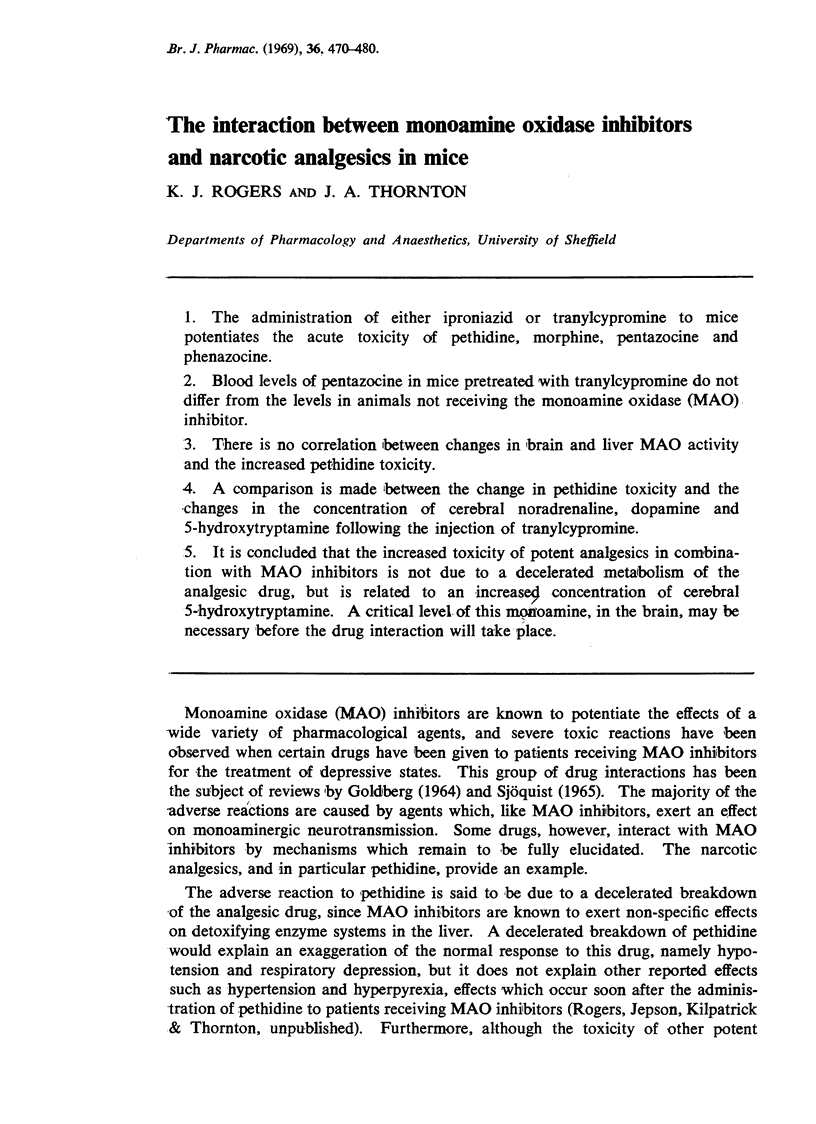
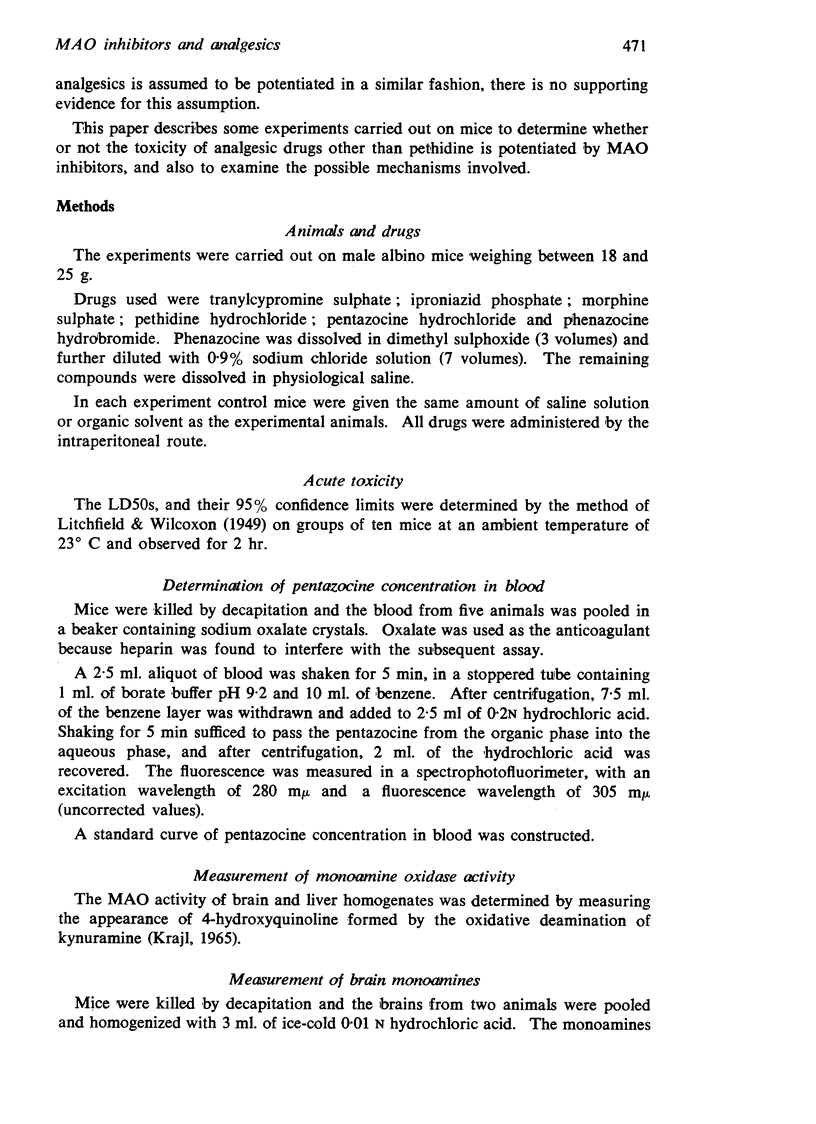
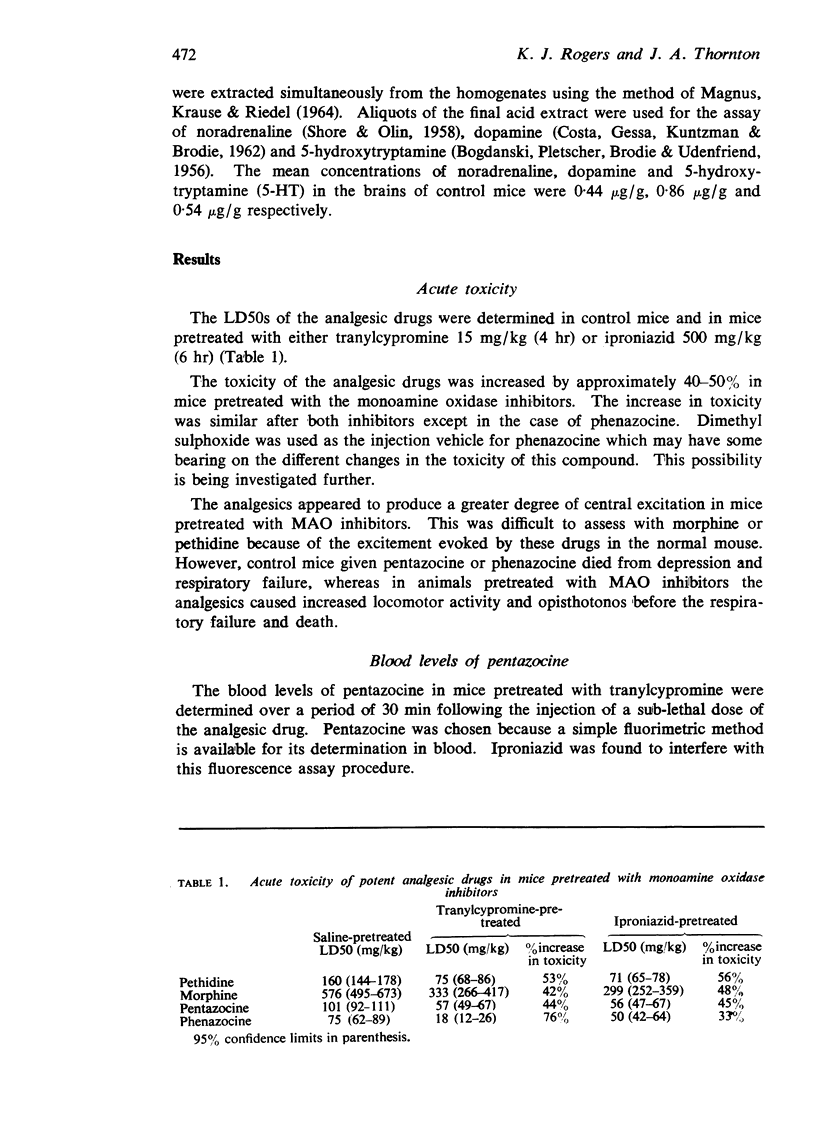
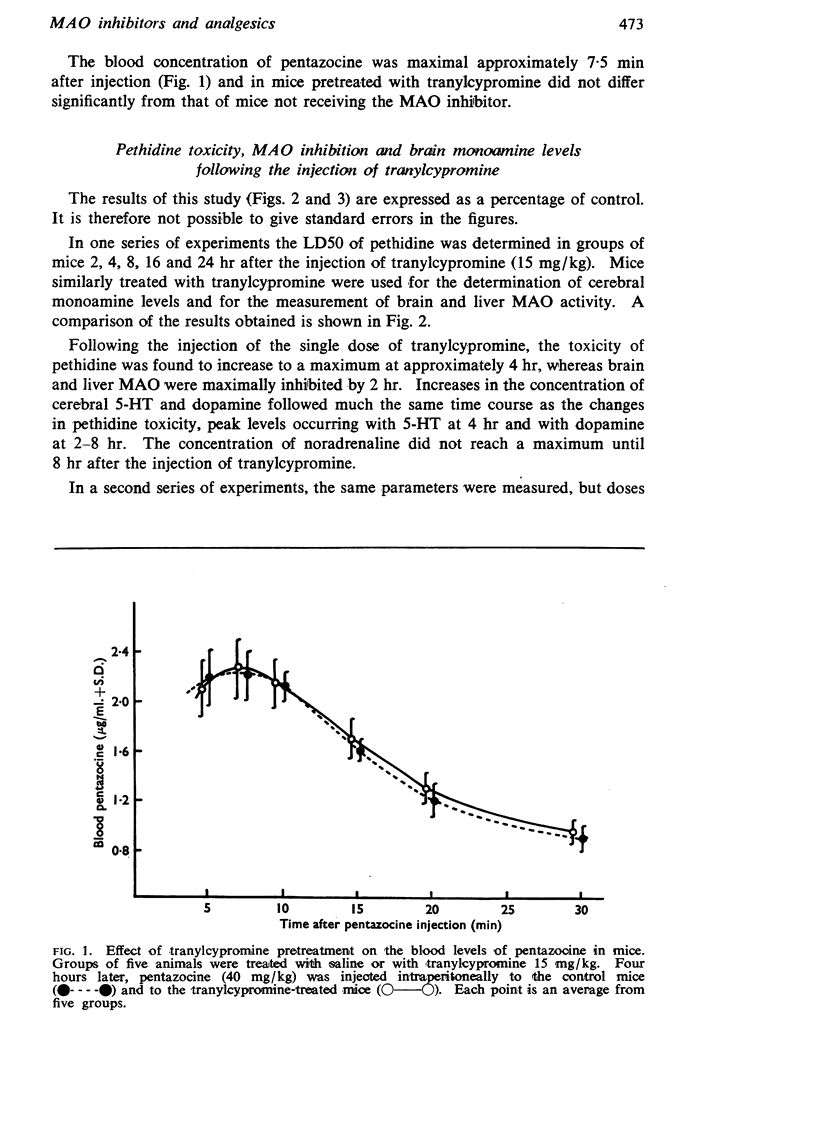
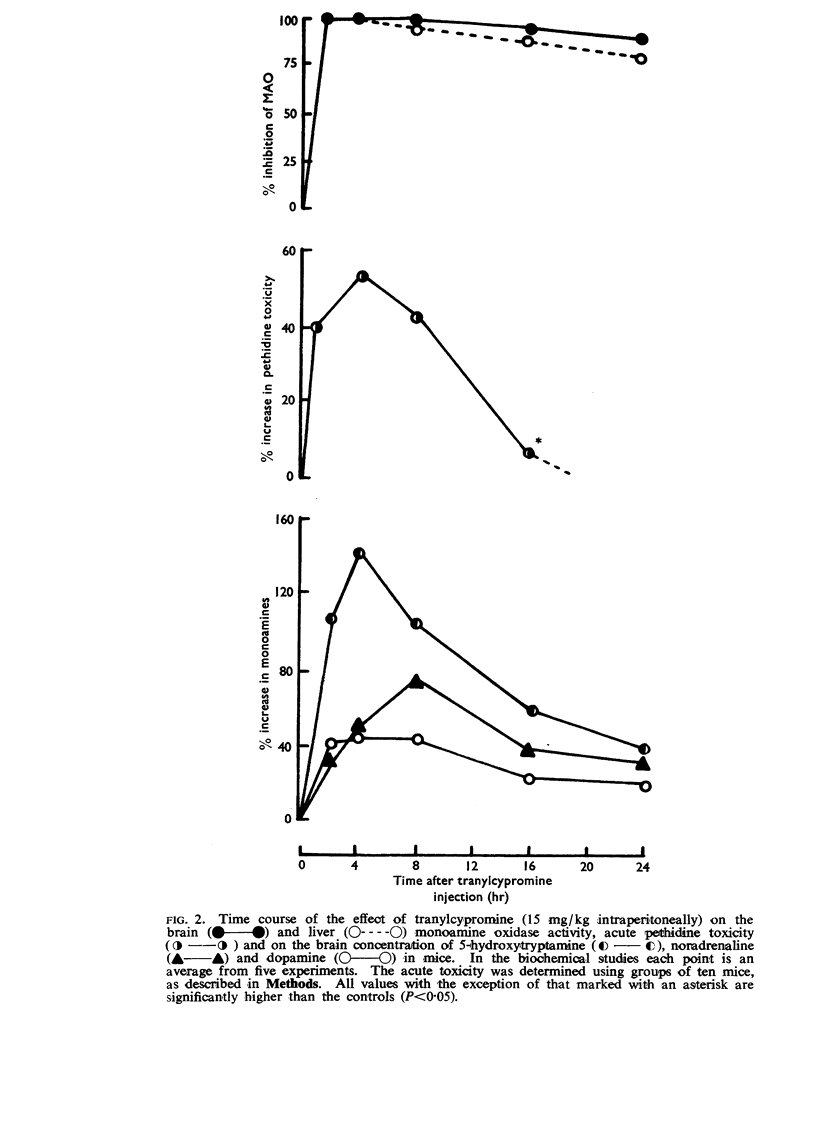
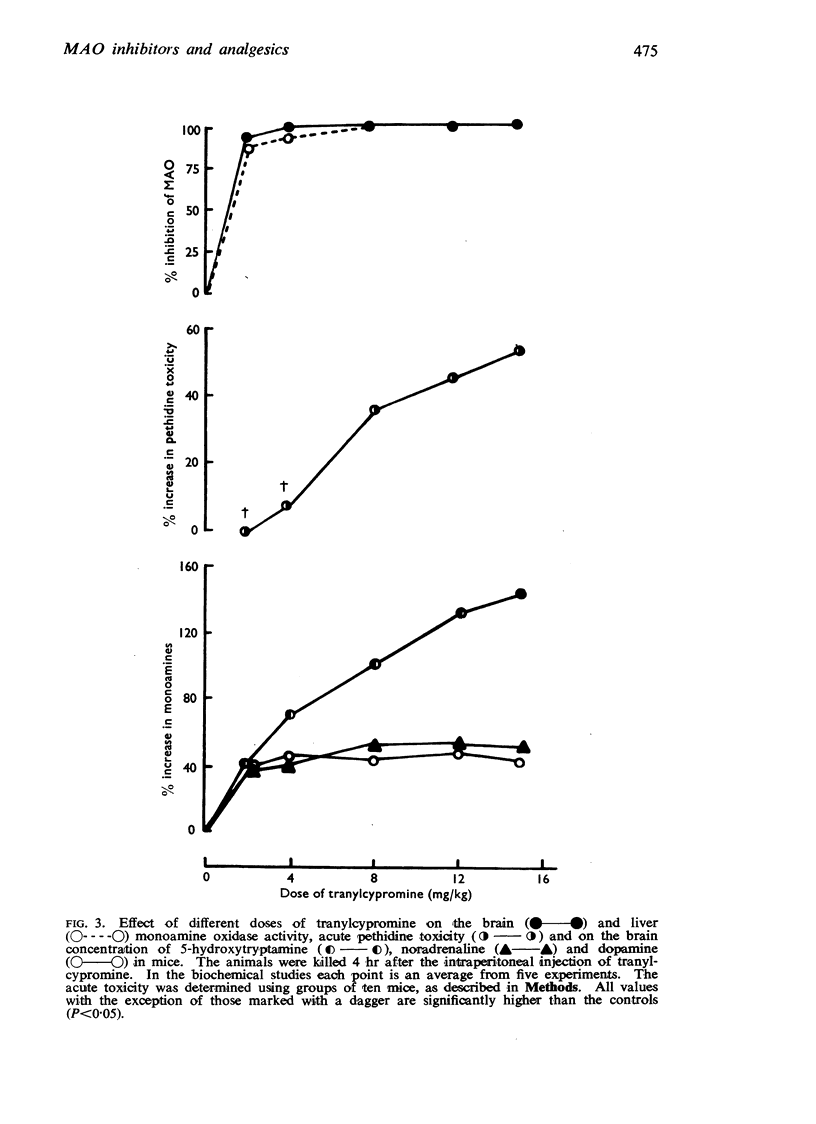
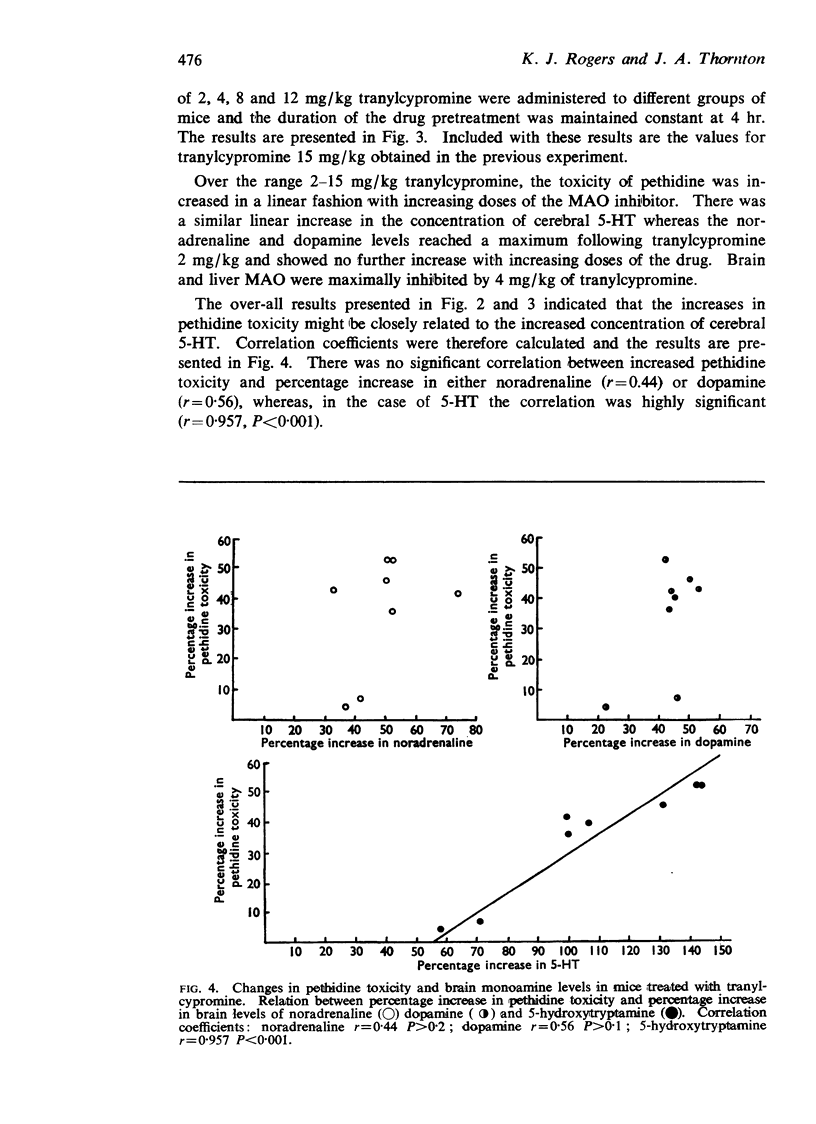
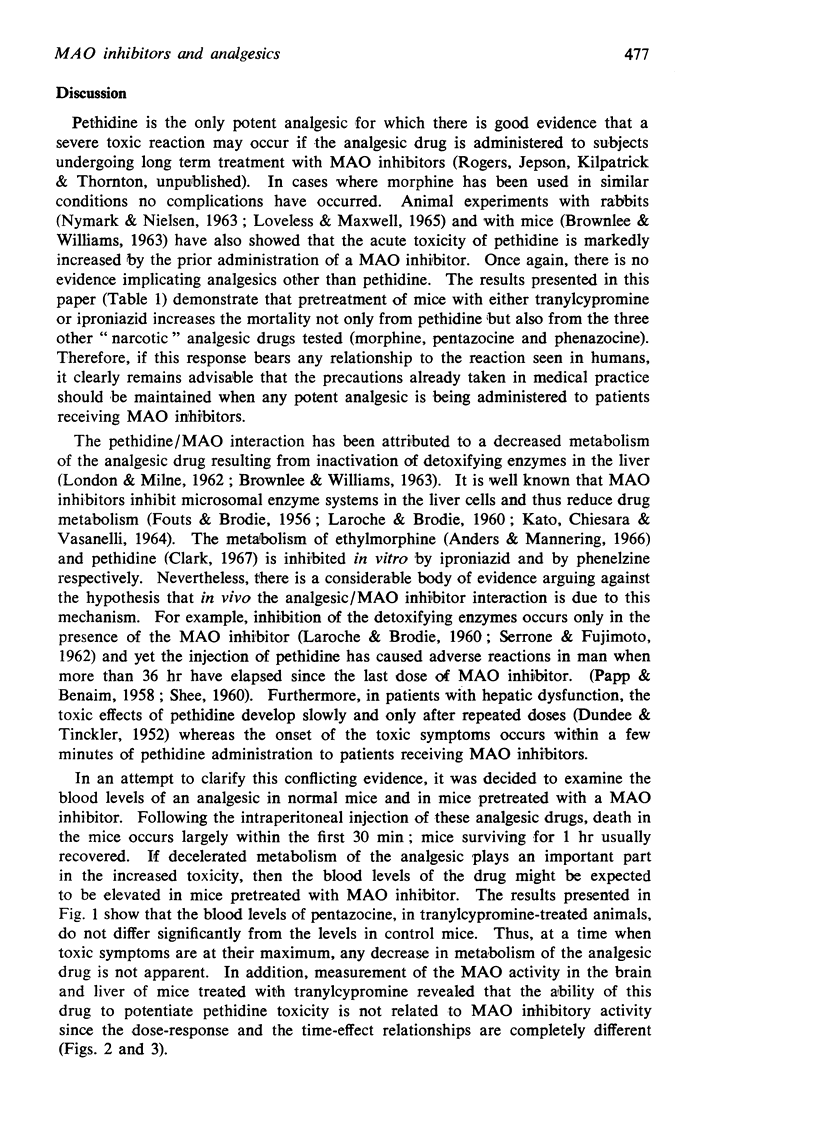
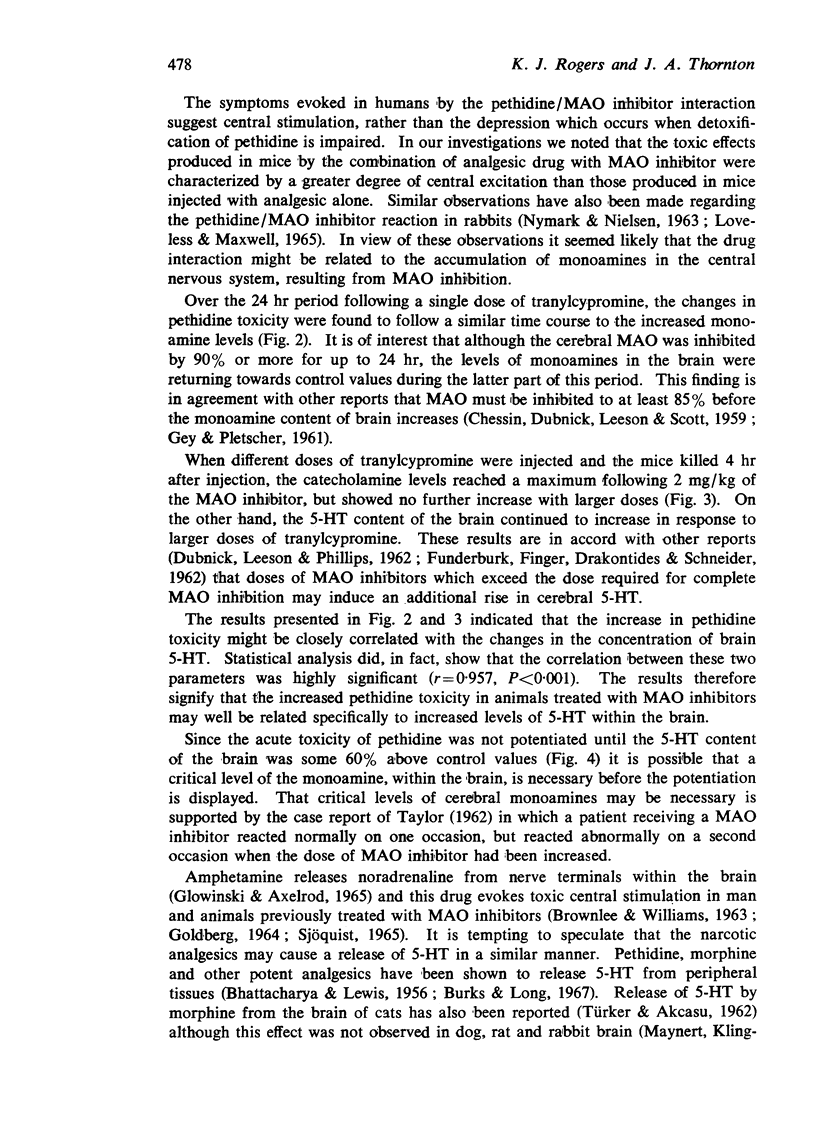
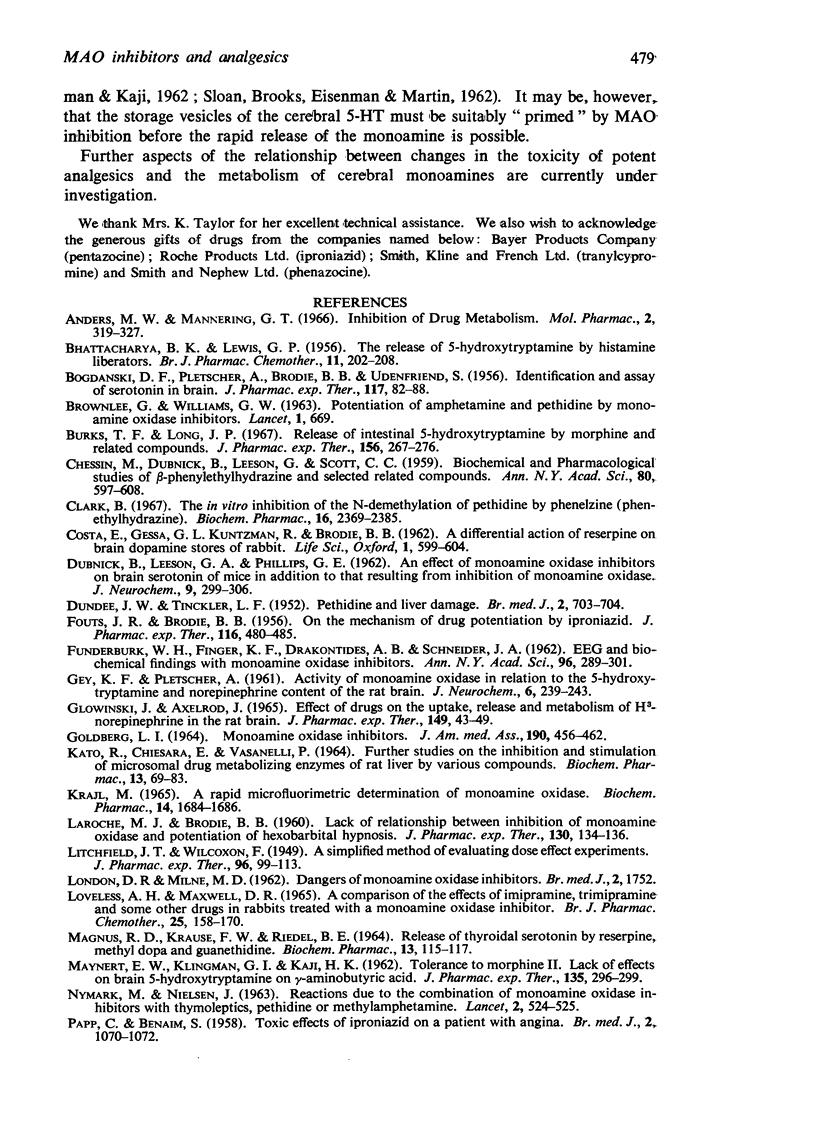

Selected References
These references are in PubMed. This may not be the complete list of references from this article.
- Anders M. W., Mannering G. J. Inhibition of drug metabolism. I. Kinetics of the inhibition of the N-demethylation of ethylmorphine by 2-diethylaminoethyl 2,2-diphenylvalerate HC1 (SKF 525-A) and related compounds. Mol Pharmacol. 1966 Jul;2(4):319–327. [PubMed] [Google Scholar]
- BHATTACHARYA B. K., LEWIS G. P. The release of 5-hydroxytryptamine by histamine liberators. Br J Pharmacol Chemother. 1956 Jun;11(2):202–208. doi: 10.1111/j.1476-5381.1956.tb01054.x. [DOI] [PMC free article] [PubMed] [Google Scholar]
- BOGDANSKI D. F., PLETSCHER A., BRODIE B. B., UNDENFRIEND S. Identification and assay of serotonin in brain. J Pharmacol Exp Ther. 1956 May;117(1):82–88. [PubMed] [Google Scholar]
- BROWNLEE G., WILLIAMS G. W. Potentiation of amphetamine and pethidine by monoamineoxidase inhibitors. Lancet. 1963 Mar 23;1(7282):669–669. doi: 10.1016/s0140-6736(63)91307-2. [DOI] [PubMed] [Google Scholar]
- Burks T. F., Long J. P. Release of intestinal 5-hydroxytryptamine by morphine and related agents. J Pharmacol Exp Ther. 1967 May;156(2):267–276. [PubMed] [Google Scholar]
- CHESSIN M., DUBNICK B., LEESON G., SCOTT C. C. Biochemical and pharmacological studies of beta-phenylethylhydrazine and selected related compounds. Ann N Y Acad Sci. 1959 Sep;80:597–608. doi: 10.1111/j.1749-6632.1959.tb49238.x. [DOI] [PubMed] [Google Scholar]
- COSTA E., GESSA G. L., KUNTZMAN R., BRODIE B. B. A differential action of reserpine on brain dopamine stores in rabbit. Life Sci. 1962 Nov;1:599–604. doi: 10.1016/0024-3205(62)90091-7. [DOI] [PubMed] [Google Scholar]
- Clark B. The in vitro inhibition of the N-demethylation of pethidine by phenelzine (Phenethylhydrazine). Biochem Pharmacol. 1967 Dec;16(12):2369–2385. doi: 10.1016/0006-2952(67)90222-5. [DOI] [PubMed] [Google Scholar]
- DUBNICK B., LEESON G. A., PHILLIPS G. E. An effect of monoamine oxidase inhibitors on brain serotonin of mice in addition to that resulting from inhibition of monoamine oxidase. J Neurochem. 1962 May-Jun;9:299–306. doi: 10.1111/j.1471-4159.1962.tb09452.x. [DOI] [PubMed] [Google Scholar]
- DUNDEE J. W., TINCKLER L. F. Pethidine and liver damage. Br Med J. 1952 Sep 27;2(4786):703–704. doi: 10.1136/bmj.2.4786.703. [DOI] [PMC free article] [PubMed] [Google Scholar]
- FOUTS J. R., BRODIE B. B. On the mechanism of drug potentiation by iproniazid (2-isopropyl-1-isonicotinyl hydrazine). J Pharmacol Exp Ther. 1956 Apr;116(4):480–485. [PubMed] [Google Scholar]
- FUNDERBURK W. H., FINGER K. F., DRAKONTIDES A. B., SCHNEIDER J. A. EEG and biochemical findings with MAO inhibitors. Ann N Y Acad Sci. 1962 Jan 13;96:289–302. doi: 10.1111/j.1749-6632.1962.tb50123.x. [DOI] [PubMed] [Google Scholar]
- GEY K. F., PLETSCHER A. Activity of monoamine oxidase in relation to the 5-hydroxytrypatamine and norepinephrine content of the rat brain. J Neurochem. 1961 Feb;6:239–243. doi: 10.1111/j.1471-4159.1961.tb13471.x. [DOI] [PubMed] [Google Scholar]
- GLOWINSKI J., AXELROD J. EFFECT OF DRUGS ON THE UPTAKE, RELEASE, AND METABOLISM OF H3-NOREPINEPHRINE IN THE RAT BRAIN. J Pharmacol Exp Ther. 1965 Jul;149:43–49. [PubMed] [Google Scholar]
- GOLDBERG L. I. MONOAMINE OXIDASE INHIBITORS. ADVERSE REACTIONS AND POSSIBLE MECHANISMS. JAMA. 1964 Nov 2;190:456–462. [PubMed] [Google Scholar]
- KATO R., CHIESARA E., VASSANELLI P. FURTHER STUDIES ON THE INHIBITION AND STIMULATION OF MICROSOMAL DRUG METABOLIZING ENZYMES OF RAT LIVER BY VARIOUS COMPOUNDS. Biochem Pharmacol. 1964 Jan;13:69–83. doi: 10.1016/0006-2952(64)90080-2. [DOI] [PubMed] [Google Scholar]
- Krajl M. A rapid microfluorimetric determination of monoamine oxidase. Biochem Pharmacol. 1965 Nov;14(11):1684–1686. doi: 10.1016/0006-2952(65)90025-0. [DOI] [PubMed] [Google Scholar]
- LAROCHE M. J., BRODIE B. B. Lack of relationship between inhibition of monoamine oxidase and potentiation of hexobarbital hypnosis. J Pharmacol Exp Ther. 1960 Oct;130:134–137. [PubMed] [Google Scholar]
- MAGUS R. D., KRAUSE F. W., RIEDEL B. E. RELEASE OF THYROIDAL SEROTONIN BY RESERPINE, METHYLDOPA AND GUANETHIDINE. Biochem Pharmacol. 1964 Jan;13:115–117. doi: 10.1016/0006-2952(64)90085-1. [DOI] [PubMed] [Google Scholar]
- MAYNERT E. W., KLINGMAN G. I., KAJI H. K. Tolerance to morphine. II. Lack of effects on brain 5-hydroxytryptamine and gamma-aminobutyric acid. J Pharmacol Exp Ther. 1962 Mar;135:296–299. [PubMed] [Google Scholar]
- NYMARK M., NIELSEN I. M. REACTIONS DUE TO THE COMBINATION OF MONOAMINEOXIDASE INHIBITORS WITH THYMOLEPTICS, PETHIDINE, OR METHYLAMPHETAMINE. Lancet. 1963 Sep 7;2(7306):524–525. doi: 10.1016/s0140-6736(63)90265-4. [DOI] [PubMed] [Google Scholar]
- PAPP C., BENAIM S. Toxic effects of iproniazid in a patient with angina. Br Med J. 1958 Nov 1;2(5104):1070–1072. doi: 10.1136/bmj.2.5104.1070. [DOI] [PMC free article] [PubMed] [Google Scholar]
- SERRONE D. M., FUJIMOTO J. M. The effect of certain inhibitors in producing shortening of hexobarbital action. Biochem Pharmacol. 1962 Jul;11:609–615. doi: 10.1016/0006-2952(62)90122-3. [DOI] [PubMed] [Google Scholar]
- SHEE J. C. Dangerous potentiation of pethidine by iproniazid, and its treatment. Br Med J. 1960 Aug 13;2(5197):507–509. doi: 10.1136/bmj.2.5197.507. [DOI] [PMC free article] [PubMed] [Google Scholar]
- SHORE P. A., OLIN J. S. Identification and chemical assay of norepinephrine in brain and other tissues. J Pharmacol Exp Ther. 1958 Mar;122(3):295–300. [PubMed] [Google Scholar]
- SLOAN J. W., BROOKS J. W., EISENMAN A. J., MARTIN W. R. Comparison of the effects of single doses of morphine and thebaine on body temperature, activity, and brain and heart levels of catecholamines and serotonin. Psychopharmacologia. 1962 Oct 5;3:291–301. doi: 10.1007/BF00411369. [DOI] [PubMed] [Google Scholar]


